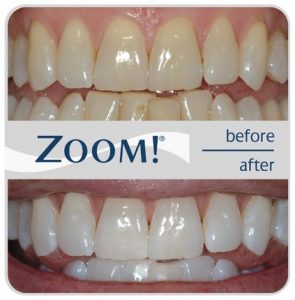Fast, Effective & Affordable Teeth Whitening
Have you ever looked in the mirror and thought that your teeth just don’t seem to be as white as they could be? There are many causes for teeth looking dingy or yellow. The main culprits are genetics, age and the food you eat. There are several ways to correct this problem and in this article we’ll give you the facts you need to know so you can decide if teeth whitening is right for you.
The long and the short of it is that teeth whitening works. Virtually everyone who chooses a professional for this painless treatment will see moderate to substantial improvement in the brightness and whiteness of their smile. First, let’s look at some of the main causes of why your smile is not bright.
What Are Some of the Causes Tooth Staining?
Age: There is a direct correlation between tooth color and age. Over the years, teeth darken as a result of wear and tear and stain accumulation. In your twenties, the teeth begin to show a yellow cast. By your forties, the yellow gives way to brown and whitening may be needed. By the fifties, teeth have absorbed stubborn stains which can be difficult, but not impossible, to remove.
Starting color: It’s in the genes. We are all born with the tooth color that our parents gave us. This can range from yellow-brownish to greenish-grey that intensifies over time. Some people just have whiter teeth than others all their life. Fortunately, you can do something about the color of your teeth.
Translucency and thinness: Another genetic factor is tooth translucency and thickness. Teeth that are opaque and thick have an advantage: they appear lighter in color, show more sparkle and are responsive to whitening treatments.
Eating habits: This is the one cause that you can control. Frequently consuming red wine, coffee, tea, cola, carrots, oranges, and other deeply-colored beverages and foods cause staining over the years. Acidic foods such as citrus fruits and vinegar contribute to enamel erosion. As a result, the surface becomes more transparent and a dingy, yellow color over time.
Smoking habits: This reason is very self-evident. Tar and nicotine leave brownish deposits which slowly soak into the tooth structure and cause intrinsic discoloration.
Drugs and chemicals: Tetracycline usage during tooth formation produces dark grey or brown ribbon stains which are very difficult to remove.
Grinding: Most frequently caused by stress, teeth grinding (gnashing, bruxing, etc.) can add to micro-cracking in the teeth and can cause the biting edges to darken.
Teeth Whitening Options
There are three major teeth whitening options are available to you today. All three rely on varying concentrations of peroxide and varying application techniques over a period of time. Application time and costs are other factors to consider.
In-Office Whitening
For the most significant color change in a short period of time, in-office whitening is the  best option. This treatment involves the carefully controlled use of a relatively high-concentration peroxide gel, applied to the teeth by a dentist or trained technician after the gums have been protected with a paint-on rubber dam.
best option. This treatment involves the carefully controlled use of a relatively high-concentration peroxide gel, applied to the teeth by a dentist or trained technician after the gums have been protected with a paint-on rubber dam.
Generally, the peroxide remains on the teeth for several 15 to 20 minute intervals that add up to an hour. Stubborn staining may need a return for additional sessions, or may be required to continue with a home-use whitening system. Get up to $150 off your teeth whitening treatment today!
Professionally Dispensed Take-Home Whitening Kits
This type of treatment take-home whitening kits can produce the excellent results over the long haul. Take-home kits incorporate an easy-to-use lower-concentration peroxide gel that remains on the teeth for an hour or longer. The gel is applied to the teeth using custom-made bleaching trays that resemble mouth guards. The downside is finding the time to apply the treatment and the longer, more frequent application.
Over-the-Counter Whitening
The cheapest option is over-the-counter bleaching kits. These have much lower concentration of bleaching gel than that of the professionally dispensed take-home whiteners. The gel is applied to the teeth via one-size-fits-all whitening strips or paint-on applicators. In many cases this may only whiten a few of the front teeth and results take many applications over several weeks.
Selecting the Best Treatment For You
Which treatment should you choose? The answer really depends on the condition of your teeth and the quality of results that you want to achieve. Over-the-counter whitening may not give you the brightness that you desire as fast as you want. A good place to start is to come in for a complimentary whitening consultation where we can discuss the merits of your options.


